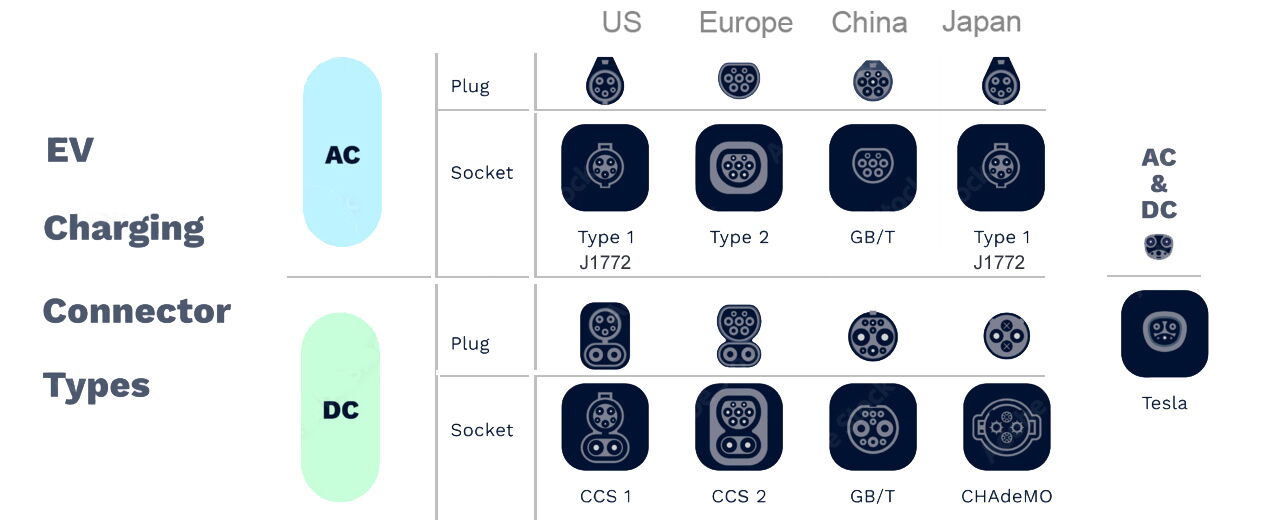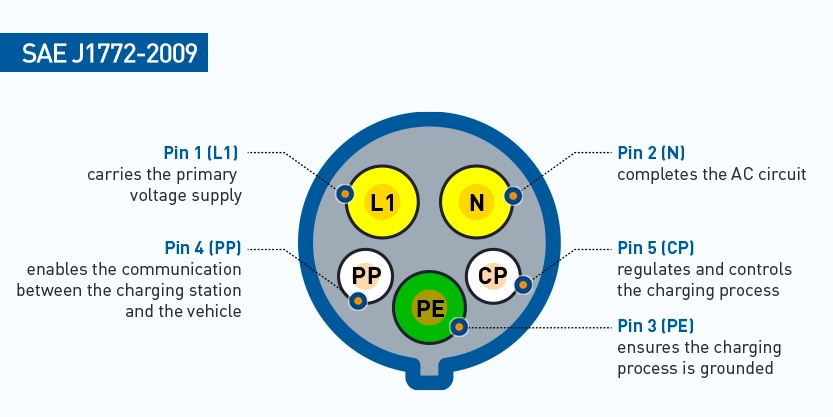As the electric vehicle (EV) industry grows, so too does the need for universal charging standards that can ensure compatibility and efficiency across a wide range of vehicles and charging infrastructure. Among the most widely discussed standards are the J1772 and CCS (Combined Charging System) connectors. Both play crucial roles in the EV ecosystem, but they differ significantly in terms of design, functionality, and capabilities. In this article, we explore the key differences between J1772 and CCS, their benefits, and which vehicles use these charging systems.

The J1772 standard, developed by the Society of Automotive Engineers (SAE), is often referred to as Type 1 in North America. This charging protocol has become the primary standard for Level 1 and Level 2 EV charging in the United States and Canada. The J1772 connector is commonly used for charging electric vehicles (EVs) and plug-in hybrid electric vehicles (PHEVs) and is integral to the region’s EV charging infrastructure.
The J1772 connector is easily recognizable due to its round shape, which houses five pins:
Two for the power connection
One for an earth-ground connection
Two for communication between the EV and the electric vehicle supply equipment (EVSE), commonly known as the charging station.
The power pins deliver alternating current (AC), while the communication pins enable the vehicle and charging station to exchange information. This handshake protocol is essential for ensuring safe and efficient power transfer, including data on the charging rate, maximum current, and the vehicle’s specific charging needs.

The J1772 connector is widely used by most electric vehicles in North America. Popular models from manufacturers such as Chevrolet, Nissan, Ford, and Toyota all utilize the J1772 standard for AC charging. This includes both Level 1 and Level 2 charging, which are suitable for home charging and public charging stations alike.
The J1772 connector is almost universally supported by Level 1 and Level 2 charging stations in North America, making it easy for EV owners to find a compatible charging station.
The J1772 connector was designed with user convenience in mind. It features a simple and easy-to-use interface, with built-in safety mechanisms to prevent electric shock during operation.
Compared to fast-charging alternatives such as CCS and CHAdeMO, J1772-based charging equipment is typically more affordable. This makes it a cost-effective solution for home and public charging stations.
The Combined Charging System (CCS) was developed as a response to the growing demand for faster and more versatile EV charging solutions. The CCS standard merges both AC charging (similar to J1772) and DC fast charging capabilities into a single connector. This makes it possible to use the same plug for both slow and fast charging, reducing the need for multiple types of connectors.
The CCS connector is an extension of the J1772 interface, building upon its basic design by adding two larger pins that are specifically dedicated to DC fast charging. This allows the connector to handle high-power DC charging, enabling much faster charge times than the standard AC connection. The result is a more flexible and efficient charging solution that meets a wide range of user needs.
The CCS connector uses a combination of three AC pins (similar to J1772) and two additional larger DC pins to support DC fast charging. This hybrid approach allows CCS-equipped vehicles to use both AC and DC chargers, offering greater charging versatility.
CCS-equipped vehicles are becoming increasingly common, especially in Europe and the United States. Major automakers like BMW, Volkswagen, Ford, Chevrolet, and Porsche all offer vehicles that are compatible with CCS. These vehicles can take advantage of both Level 1/Level 2 AC charging and DC fast charging using the same connector.
The most significant advantage of the CCS system is its ability to handle DC fast charging, significantly reducing charging times compared to traditional AC charging. For example, with a CCS connection, EVs can charge up to 80% in under an hour, depending on the charging station’s power output.
As the adoption of CCS-enabled EVs grows, the network of DC fast chargers continues to expand. This trend is particularly important for long-distance travel, as it allows drivers to quickly recharge their vehicles at public charging stations.
One of the main benefits of CCS is its dual charging compatibility. It supports both AC (Level 1 and Level 2) and DC fast charging, providing users with a greater number of charging options depending on the circumstances.
|
Feature |
J1772 |
CCS (Combined Charging System) |
|
Type of Charging |
Primarily AC (Level 1 and Level 2) |
Both AC and DC (Level 1, Level 2, and DC fast charging) |
|
Number of Pins |
5 Pins |
7 Pins (3 for AC, 2 larger pins for DC) |
|
Fast Charging Support |
No |
Yes (DC fast charging) |
|
Usage Area |
Primarily North America |
Europe, North America, and expanding globally |
|
Charging Speed |
Slower (AC charging) |
Faster (AC and DC fast charging) |
|
Vehicle Compatibility |
Most EVs and PHEVs in North America |
Newer EVs from major manufacturers (BMW, Ford, etc.) |
The J1772 and CCS standards serve distinct but complementary roles in the world of electric vehicle charging. While J1772 remains the most widely used connector for Level 1 and Level 2 charging in North America, the CCS standard offers an upgraded, faster charging solution with both AC and DC compatibility. As the EV market continues to evolve, both charging standards will likely coexist, with CCS becoming increasingly prevalent in the realm of DC fast charging and long-distance travel.
No, the Type 2 connector (also known as Mennekes) is the European standard and is not compatible with the J1772 connector, which is more commonly used in North America. Type 2 connectors are typically used for Level 2 AC charging in Europe.
Tesla uses a proprietary connector for its Supercharger stations, which is not directly compatible with J1772. However, Tesla vehicles sold in North America come with an adapter that allows them to use J1772 chargers. As for Supercharger stations, only CCS-enabled vehicles can use Tesla’s Supercharger network through an adapter (in some regions).
While J1772 is a universal standard used by most EV manufacturers in North America, Tesla uses its own proprietary charging connector for both its Superchargers and Level 2 chargers. Tesla vehicles in North America are equipped with a J1772 adapter, enabling them to charge at non-Tesla stations.
No, CHAdeMO is a Japanese-developed standard primarily used for DC fast charging. Unlike J1772, which is mainly for AC charging, CHAdeMO requires a separate port on the vehicle for DC fast charging. It’s becoming less common in favor of CCS, especially in Europe and North America.